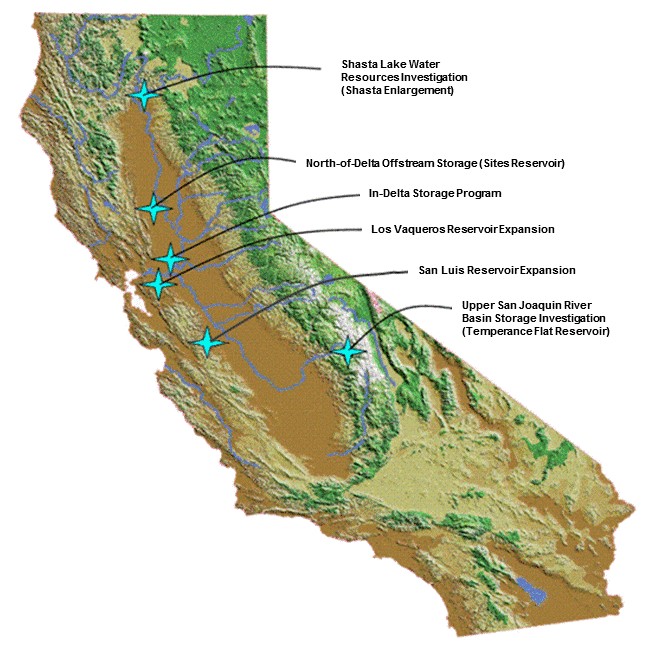Statewide Infrastructure Investigations
The Statewide Infrastructure Investigations Branch provides planning and technical expertise across DWR programs in support of sustainable water resources management. We conduct robust planning, feasibility, environmental, and technical analysis to identify tradeoffs, analyze alternatives, and make recommendations to inform risk-based and outcome-driven decision-making.
We are currently investigating three surface water storage projects:
- North-of-the-Delta Offstream Storage (NODOS)
- Los Vaqueros Expansion Investigation
- Upper San Joaquin River Basin Storage Investigation
- Shasta Lake Water Resources Investigation

North-of-the-Delta Offstream Storage Investigation
DWR, the U.S. Bureau of Reclamation (Reclamation), and local partners are studying the feasibility of an offstream surface reservoir north of the Sacramento-San Joaquin Delta.
North-of-the-Delta Offstream Storage (NODOS) would increase water supply reliability, provide ecosystem enhancement, improve water quality for Delta water users, generate hydropower to support renewable energy sources such as wind and solar, create recreation opportunities, and reduce flood damage potential below the new reservoir. NODOS would add up to 500,000 acre-feet (500 TAF) of water supply benefits, on average, per year.
NODOS would also support improved flexibility and long-term viability of the Central Valley Project (CVP) and State Water Project (SWP). As the recent drought showed, operational flexibility of these two projects is impaired during multiple dry years. With NODOS in place, water storage in the system could see increases of up to 1.4 million acre-feet (MAF) per year in multi-year droughts, and up to 1.1 MAF per year in singular dry years.
NODOS Documents
The following documents are available upon request.
- Investigation Highlights, May 2014
- Preliminary Administrative Draft Environmental Impact Report - May 2014
- Preliminary Engineering Design and Cost Estimate Report - May 2014
- Progress Report on Feasibility Study - December 2013
Los Vaqueros Expansion Investigation
Contra Costa Water District (CCWD) is collaborating with local, state, and federal agencies and stakeholders on the formulation and development of a project to increase Los Vaqueros Reservoir from its current capacity of 160 thousand acre-feet (TAF) would be expanded up to a total of 275 TAF.
Los Vaqueros Reservoir provides offstream water storage to improve water quality and provide emergency storage for CCWD customers. Water stored in Los Vaqueros Reservoir is diverted from the Delta at the existing Old River Pump Station. New Delta intakes, pumps, and pipelines would be required to fill the additional reservoir capacity.
The proposed project would improve Bay Area water supply reliability and water quality while protecting Delta fisheries and providing additional Delta ecosystem benefits.
Status: CCWD completed the draft supplement to the Final EIS/EIR for the project in 2017. For more information about this project, go to CCWD’s website: http://www.ccwater.com/709/Expansion-Documents
Upper San Joaquin River Basin Storage Investigation
The Upper San Joaquin River Basin Storage Investigation is a feasibility study being performed by Reclamation in collaboration with DWR and the San Joaquin Valley Water Infrastructure Authority.
The purpose of the investigation is to determine interests in a potential dam project in the upper San Joaquin River watershed to expand water storage capacity to improve water supply reliability and flexibility for agricultural, urban, and environmental uses.
Status:
- Completed Draft Environmental Impact Statement (2014)
- Completed Draft Feasibility Report (2014)
For more information about this project, go to U.S. Bureau of Reclamation’s website: http://www.usbr.gov/mp/sccao/storage/
Shasta Lake Water Resources Investigation
Reclamation has completed the investigation of the enlargement of Shasta Dam and Reservoir to increase the cold water available for maintaining lower Sacramento River temperatures and to improve water supply reliability for other beneficial uses.
The project is intended to increase water supply and water supply reliability for agricultural, municipal, industrial, and environmental purposes and increase survival of anadromous fish populations in the upper Sacramento River.
Raising Shasta Dam 6.5 feet would inundate up to an estimated additional 1,420 lineal feet of the lower McCloud River. For a dam raise of 18.5 feet, up to an estimated additional 3,480 feet of the lower McCloud River would be inundated. The McCloud River is an area of specific interest. California Public Resources Code 5093.542(c) restricts state participation in studies to enlarge Shasta Dam and Reservoir if that action could have an adverse effect on the free-flowing conditions of the McCloud River or its wild trout fisheries.
Status
DWR stopped work on the Shasta Lake Water Resources Investigation in July 2005 due to lack of funding. U.S. Bureau of Reclamation is the federal lead agency for the project.
U.S. Bureau of Reclamation has completed the final feasibility report and environmental impact statement (2015). For more information about this project, go to U.S. Bureau of Reclamation’s website: http://www.usbr.gov/mp/slwri
In-Delta Storage
The In-Delta Storage Project would provide capacity to store approximately 217,000 acre-feet of water in the south Delta for a wide array of water supply, water quality and ecosystem benefits. The project would include two storage islands (Webb Tract and Bacon Island) and two habitat islands (Holland Tract and Bouldin Island).
Status
DWR, in coordination with California Bay-Delta Authority and with technical assistance from U.S. Bureau of Reclamation, completed the In-Delta Storage Program State Feasibility Study Report in 2004 and a Draft Supplemental Feasibility Report in 2006. The State feasibility study addresses engineering feasibility and risk, revised project operations that address drinking water quality concerns, project cost analyses, and potential project benefits and effects.
The In-Delta Storage Program was suspended in July 2006 when State funding for the program was cut.